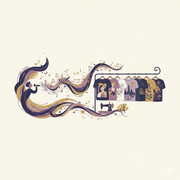The culture of K-pop and immersive performance space have collided in unexpected new forms and no place is it more clear than the phenomenon of Gangnam Karaoke & Shirt Room. Indeed, the idea echoes the spirit of Gangnam Hyper Republic You & Me (강남하이퍼블릭 유앤미), which is a phrase that implies community performance and closely working together. This is not only a karaoke bar, it is a living art installation, a canvas of sound, expression and statement of style.
The Aesthetical Basis of Karaoke as an Art
Music and art are inseparable brothers. They both provide meaning to emotion, story, and self. However, the experience is enhanced with a karaoke room fitted with pre-curated wardrobe choices, the “Shirt Room”. Clients wear stylized costumes or shirts, enter rooms with theatrical lighting, and act not only with songs but persona. Ineffectually, all performances are participatory art.
This is in line with concepts covered in the gallery world, the meaning made through space, objects, and interaction of visitors.
Sound, Costume, and Identity in the Room
Watch all these three elements clashing together in order to create an artistic K-pop culture:
Sound as Medium
Every karaoke booth is like a personal stage. The track is also of high end audio with ambient lighting making it immersive. The singer is not merely miming, he or she is making improvised performances which have short lives.
Costume as Expression
The Shirt Room helps the user to use visual narratives. A mere shirt or jacket may provoke the sense of alternate identity, dramatizing, or aesthetic atmosphere. It is like costume design in art or theater that defines identity.
Staging and Lighting
Light is the mute of mood. One spotlight, a saturated color panel, or backlit shadows can make a little room a drama stage. It is similar to the idea of the museums and the exhibitions reimagining works with dynamic lighting as time goes by.
Cultural Situation: K-culture and Art Space Fusion
 The fact that Gangnam is a trendsetter, a district with cutting edge reputation, makes it an appropriate place to make this hybrid start. The location is a crusting of street culture, night life, performance art, and self-expression. By so doing, it captures a charged moment, of the merging of entertainment, identity, and spectacle of creativity.
The fact that Gangnam is a trendsetter, a district with cutting edge reputation, makes it an appropriate place to make this hybrid start. The location is a crusting of street culture, night life, performance art, and self-expression. By so doing, it captures a charged moment, of the merging of entertainment, identity, and spectacle of creativity.
Such space may even serve as a living gallery in the context of art: performers are participants in the performance, the audience is viewer and performer at the same time, and the costume is the art object.
Room by Room: Things You May Experience
- Solo Stage Rooms: Are used when an individual singer desires to have light control, change costumes and a dramatic aspect.
- Group Booths: When friends or performers are singing songs together, or in a duet, and wardrobe corresponds to the topics.
- Concept Rooms: Dress like a concept (retro, futuristic, noir).
- Gallery Wall: This is a small stand-alone space that features iconic performances or outfits as archives.
Each room takes the limit of intimate indulgence and staged spectacle to the edge.
Connecting into the Bigger Picture of Art Discourse
The conception of Gangnam Karaoke and Shirt Room is a perfect supplement to the discussion of performance art, interactive installation, and relational aesthetics. Those readers who may be interested in understanding how art develops may look into such topics as Artistic Claims of Knowledge, which can deepen their theoretical background.
Conclusions: Social Art Performance, Identity, and Future
Gangnam Karaoke & Shirt Room is not merely about entertainment it is an equation of life. Pose, voice, light, costume equals new identity in real time. It appeals to this form of performance in the society by addressing it using the name of the Gangnam Hyper Republic You & Me. It is an uncommon convergence to observe and to participate in, even among art lovers. The future of social art may well be in an area where the audience, artist and costume curator are one.
